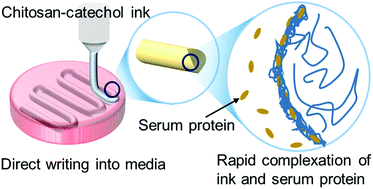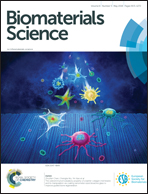Chitosan-catechol: a writable bioink under serum culture media†
Abstract
Mussel-inspired adhesive coatings on biomedical devices have attracted significant interest due to their unique properties such as substrate independency and high efficiency. The key molecules for mussel-inspired adhesive coatings are catechol and amine groups. Along with the understanding of catechol chemistry, chitosan-catechol has also been developed as a representative mussel-inpired adhesive polymer that contains catechol and amine groups for adhesiveness. Herein, we demonstrated the direct writability of chitosan-catechol as a bioink for 3D printing, one of the additive techniques. The use of chitosan-catechol bioink results in the formation of 3D constructs in normal culture media via rapid complexation of this bioink with serum proteins; in addition, the metal/catechol combination containing tiny amounts of vanadyl ions, in which the ratio of metal to catechol is 0.0005, dramatically enhances the mechanical strength and printability of the cell-encapsulated inks, showing a cell viability of approximately 90%. These findings for mussel-inspired bioinks will be a promising way to design a biocompatible 3D bioink cross-linked without any external stimuli.

- This article is part of the themed collection: Nanobiointerfaces


 Please wait while we load your content...
Please wait while we load your content...